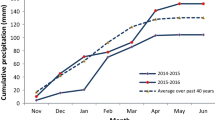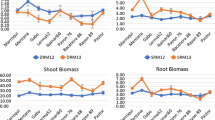Abstract
Successful crop stand establishment is critical to realize high yield potential, which is dependent on depth of seed placement to access soil moisture. The coleoptile determines sowing depth by its length and ability to emerge from depth. This study was conducted to assess coleoptile length among three sets of three Great Plains winter small grain cereals—wheat (Triticum aestivum L.), barley (Hordeum vulgare L.) and triticale (X triticosecale Wittm.)—and to evaluate the effect of the Rht-B1b dwarfing allele on coleoptile length in wheat and triticale. Fifty seeds of each genotype were sown in wet germination paper in two replications utilizing a randomized complete block design, which were placed in dark growth chambers at 25°C. Measurements were conducted after 7 d, and analysis of variance and comparison of least square means for coleoptile length among and within each set of genotypes were performed in Statistix 8.1 software using Fisher’s protected least significance difference at the α = 0.05 significance level. Results revealed that triticale had the longest coleoptiles, which were significantly longer (P < 0.05) than those measured in both barley and wheat. Additionally, significant variation in coleoptile length (P < 0.05) was also found within each set of wheat (3.52–6.41 cm), barley (4.32–6.63 cm) and triticale (4.05–6.92 cm) genotypes, respectively. These findings confirm other reports that the presence of the Rht-B1b allele was pleiotropic for coleoptile length, but development of semi-dwarf wheats with longer coleoptiles is possible if breeders deploy concurrent selection strategies.

Similar content being viewed by others
References
Allan RE, Vogel OA, Peterson CJ (1962) Seedling emergence rate of fall-sown wheat and its association with plant height and coleoptile length. Agron J 54:347–350. https://doi.org/10.2134/agronj1962.00021962005400040022x
Amram A, Fadida-Myers A, Golan G, Nashef K, Ben-David R, Peleg Z (2015) Effect of GA-sensitivity on wheat early vigor and yield components under deep sowing. Front in Plant Sci 6:487. https://doi.org/10.3389/fpls.2015.00487
Bandle J, Knott D (1986) The effect of a gene for semidwarfism (rht1) on various characters in a spring wheat cross. Can J Plant Sci 66:529–533. https://doi.org/10.4141/cjps86-072
Botwright TL, Rebetzke GJ, Condon AG, Richards RA (2005) Influence of the gibberellins-responsive Rht8 dwarfing gene on the leaf epidermal and cell dimensions and early vigour in wheat (Triticum aestivum L.) Ann of Bot 95:631–639. https://doi.org/10.1093/aob/mci069
Brown PR, Singleton GR, Tann CR, Mock I (2003) Increasing sowing depth to reduce mouse damage to winter crops. Crop Prot 22:653–660. https://doi.org/10.1016/S0261-2194(03)00006-1
Budak N, Baenziger PS, Eskridge KM, Baltensperger D, Moreno-Sevilla B (1995) Plant height response of semidwarf and nonsemidwarf wheats to the environment. Crop Sci 35:447. https://doi.org/10.2135/cropsci1995.0011183X003500020028x
Cai K, Chen X, Han Z, Wu X, Zhang S, Li Q, Nazir MM, Zhang G, Zeng F (2020) Screening of worldwide barley collection for drought tolerance: the assessment of various physiological measures as the selection criteria. Front in Plant Sci 11:1159. https://doi.org/10.3389/fpls.2020.01159
Chapman S, Mathews K, Trethowan R, Singh R (2006) Relationships between height and yield in near-isogenic spring wheats that contrast for major height reducing genes. Euphytica 157:391–397. https://doi.org/10.1007/s10681-006-9304-3
Chernook A, Kroupin P, Karlov G, Soloviev A, Korshunova A, Rubets V, Igonin V, Divashuk M (2019) Effects of Rht-B1b and Ddw1 dwarfing genes in two connecting populations of spring triticale under greenhouse experiment conditions. Agriculture 9:119. https://doi.org/10.3390/agriculture9060119
Claeys H, De-Bodt S, Inzé D (2014) Gibberellins and DELLAs: central nodes in growth regulatory networks. Trends Plant Sci 19:231–239. https://doi.org/10.1016/j.tplants.2013.10.001
Ellis M, Rebetzke G, Chandler P, Bonnett D (2004) The effect of different height reducing genes on the early growth of wheat. Funct Plant 31:583–589. https://doi.org/10.1071/FP03207
Flohr BM, Hunt JR, Kirkegaard JA, Evans JR, Trevaskis B, Zwart A, Swan A, Fletcher AL, Rheinheimer B (2018) Fast winter wheat phenology can stabilise flowering date and maximise grain yield in semi-arid Mediterranean and temperate environments. Field Crops Res 223:12–25. https://doi.org/10.1016/j.fcr.2018.03.021
Gale MD, Marshall GA (1976) Chromosome location of Gai 1 and Rht genes for gibberrelic insensitivity and semi-dwarfism in a derivative of Norin 10 wheat. Heredity 37:283–289. https://www.nature.com/articles/hdy197688
Gale MD, Marshall GA, Rao MV (1981) A classification of the Norin 10 and Tom Thumb dwarfing genes in British, Mexican, Indian and other hexaploidy bread wheat varieties. Euphytica 30:355–361. https://doi.org/10.1007/BF00033997
Gan Y, Stobbe EH, Moes J (1992) Relative date of wheat seedling emergence and its impact on grain yield. Crop Sci 32:1275–1281. https://doi.org/10.2135/cropsci1992.0011183X003200050042x
Garnett T, Conn V, Kaiser BN (2009) Root based approaches to improving nitrogen use efficiency in plants. Plant Cell Environ 32:1272–1283. https://doi.org/10.1111/j.1365-3040.2009.02011.x
Gill BS, Appels R, Botha-Oberholster AM, Buell CR, Bennetzen JL, Chalhoub B et al (2004) A workshop report on wheat genome sequencing: International Genome Research on Wheat Consortium. Genetics 168:1087–1096. https://doi.org/10.1534/genetics.104.034769
Griffiths S, Simmonds J, Leverington M, Wang Y, Fish L, Sayers L, Alibert L, Orford S, Wingen L, Snape J. (2012) Meta-QTL analysis of the genetic control of crop height in elite European winter wheat germplasm. Mol Breeding 29:159–171.https://doi.org/10.1007/s11032-010-9534-x
Guedira M, Brown-Guedira G, Van Sanford D, Sneller C, de Souza EBC, Marshall D (2010) Distribution of Rht genes in modern and historic winter wheat cultivars from the Eastern and Central USA. Crop Sci 50:1811–1822. https://doi.org/10.2135/cropsci2009.10.0626
Hedden P (2003) The genes of the green revolution. Trends Genet 19:5–9. https://doi.org/10.1016/S0168-9525(02)00009-4
Hoogendoorn J, Rickson JM, Gale MD (1990) Differences in leaf and stem anatomy related to plant height of tall and dwarf wheat (Triticum aestivum L.). J Plant Physiol 136:72–77. https://doi.org/10.1016/S0176-1617(11)81618-4
Keyes G, Sorrells M, Setter T (1990) Gibberellic acid regulates cell wall extensibility in wheat (Triticum aestivum L.). Plant Physiol 92:242–245. https://doi.org/10.1104/pp.92.1.242
Kirby EJM (1993) Effect of sowing depth on seedling emergence, growth and development in barley and wheat. Field Crops Res 35:101–111. https://doi.org/10.1016/0378-4290(93)90143-B
Li G, Bai G, Carver BF, Elliott NC, Bennett RS, Wu Y, Hunger R, Bonman JM, Xu X (2017) Genome-wide association study reveals genetic architecture of coleoptile length in wheat. Theor Appl Genet 130:391–401. https://doi.org/10.1007/s00122-016-2820-1
Li P, Chen J, Wu P, Zhang J, Chu C, See D, Brown-Guedira G, Zemetra R, Souza E (2011) Quantitative trait loci analysis for the effect of Rht-B1 dwarfing gene on coleoptile length and seedling root length and number of bread wheat. Crop Sci 51:2561–2568. https://doi.org/10.2135/cropsci2011.03.0116
Liu Y, Zhang J, Hu Y, Chen J (2017) Dwarfing genes Rht4 and Rht-B1b affect plant height and key agronomic traits in common wheat under two water regimes. Field Crops Res 204:242–248. https://doi.org/10.1016/j.fcr.2017.01.020
Mahdi L, Bell CJ, Ryan J (1998) Establishment and yield of wheat (Triticum turgidum L.) after early sowing at various depths in a semi-arid Mediterranean environment. Field Crops Res 58:187–196. https://doi.org/10.1016/S0378-4290(98)00094-X
Matsui T, Inanaga S, Shimotashiro T (2002) Morphological characters related to varietal differences in tolerance to deep sowing in wheat. Plant Prod Sci 5:169–174. https://doi.org/10.1626/pps.5.169
Mohan A, Schillinger WF, Gill KS (2013) Wheat seedling emergence from deep planting depths and its relationship with coleoptile length. PLoS ONE 8(9):e73314. https://doi.org/10.1371/journal.pone.0073314
O’Sullivan PA, Weiss GM, Friesen D (1985) Tolerance of spring wheat (Triticum aestivum L.) to trifluralin deep-incorporated in the autumn or spring. Weed Res 25:275–280. https://doi.org/10.1111/j.1365-3180.1985.tb00645.x
Rebetzke GJ, Richards RA (1999) Genetic improvement of early vigour in wheat. Aust J Agric Res 50:291. https://doi.org/10.1071/A98125
Rebetzke GJ, Bruce SE, Kirkegaard JA (2005) Longer coleoptiles improve emergence through crop residues to increase seedling number and biomass in wheat (Triticum aestivum L.). Plant Soil 272:87–100. https://doi.org/10.1007/s11104-004-4040-8
Rebetzke GJ, Richards RA, Fettell NA, Long M, Condon AG (2007a) Genotypic increases in coleoptile length improves stand establishment, vigour and grain yield of deep-sown wheat. Field Crop Res 100:10–23. https://doi.org/10.1016/j.fcr.2006.05.001
Rebetzke GJ, Ellis M (2007b) Molecular mapping of genes for coleoptile growth in bread wheat. (Triticum aestivum L.) Theor Appl Genet 114:1173–1183. https://doi.org/10.1007/s00122-007-0509-1
Rebetzke G, Bonnett D, Ellis M (2012a) Combining gibberellic acid-sensitive and insensitive dwarfing genes in breeding of higher-yielding sesqui-dwarf wheats. Field Crops Res 127:17–25. https://doi.org/10.1016/j.fcr.2011.11.003
Rebetzke G, Ellis M, Bonnett D, Mickelson B, Condon A, Richards R (2012b) Height reduction and agronomic performance for selected gibberellin-responsive dwarfing genes in bread wheat (Triticum aestivum L.) Field Crops Res 126:87–96. https://doi.org/10.1016/j.fcr.2011.09.022
Rebetzke GJ, Verbyla AP, Verbyla KL, Morell MK, Cavanagh CR (2014) Use of a large multiparent wheat mapping population in genomic dissection of coleoptile and seedling growth. Plant Biotech J 12:219–230. https://doi.org/10.1111/pbi.12130
Schillinger WF, Donaldson E, Allan RE, Jones SS (1998) Winter wheat seedling emergence from deep sowing depths. Agronomy J 90:582–586. https://doi.org/10.2134/agronj1998.00021962009000050002x
Shen Q, Fu L, Dai F, Jiang L, Zhang G, Wu D (2016) Multi-omics analysis reveals molecular mechanisms of shoot adaptation to salt stress in Tibetan wild barley. BMC Genomics 17:889. https://doi.org/10.1186/s12864-016-3249-9
Sidhu JS, Singh D, Gill HS, Brar NK, Qiu Y, Halder J, Tameemi RA, Turnipseed B, Sehgal SK (2020) Genome-wide association study uncovers novel genomic regions associated with coleoptile length in hard winter wheat. Front Genet 10:1345. https://doi.org/10.3389/fgene.2019.01345
Spielmeyer W, Hyles J, Joaquim P, Azanza F, Bonnett D et al. (2007) A QTL on chromosome 6A in bread wheat (Triticum aestivum L.). is associated with longer coleoptiles, greater seedling vigour and final plant height. Theor Appl Genet 115:59–66. https://doi.org/10.1007/s00122-007-0540-2
Whan BR (1976) The emergence of semidwarf and standard wheats, and its association with coleoptile length. Aust J Exp Ag 16:411–416. https://doi.org/10.1071/EA9760411
Yu J, Bai G (2010) Mapping quantitative trait loci for long coleoptiles in Chinese wheat landrace Wangshuibai. Crop Sci 50:43–50. https://doi.org/10.2135/cropsci2009.02.0065
Acknowledgments
P.S. Baenziger received partial financial support from the Nebraska Agricultural Experiment Station and the Nebraska Wheat Development, Utilization, and Marketing Board. Partial funding for P.S. Baenziger was from Hatch project NEB-22-328, AFRI/2011-68002-30029, the CERES Trust Organic Research Initiative, and USDA under Agreement No. 59-0790-4-092 which was a cooperative project with the U.S. Wheat & Barley Scab Initiative. M. Alam acknowledges the Higher Education Commission of Pakistan for providing funds for the research and learning and thanks Dr. P.S. Baenziger for providing research facilities.
Author information
Authors and Affiliations
Contributions
MA conducted the experiment, including the measurements, statistical analysis and helped write the manuscript. AE assisted in seed acquisition and reviewed the manuscript. FW assisted with DNA extractions, conducted genotyping and provided SNP analysis. JDB interpreted data, provided guidance and helped write and review the manuscript. PSB conceived the project, interpreted data, supervised and reviewed the manuscript.
Corresponding author
Ethics declarations
Conflict of interest
The authors have no conflicts of interest.
Supplementary Information
Below is the link to the electronic supplementary material.
Rights and permissions
About this article
Cite this article
Alam, M., Kashif, M., Easterly, A.C. et al. Coleoptile length comparison of three winter small grain cereals adapted to the Great Plains. CEREAL RESEARCH COMMUNICATIONS 50, 127–136 (2022). https://doi.org/10.1007/s42976-021-00151-3
Received:
Accepted:
Published:
Issue Date:
DOI: https://doi.org/10.1007/s42976-021-00151-3




